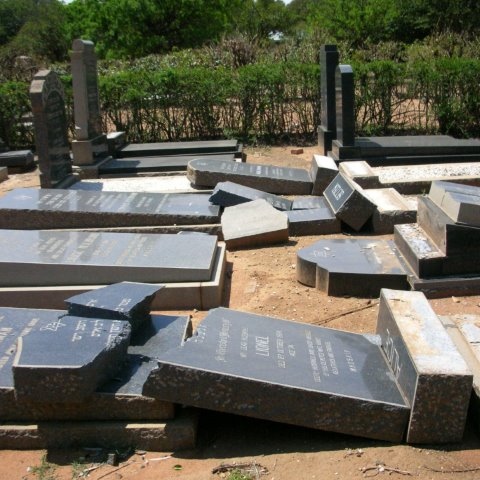
SA

A South African approach to cemetery vandalism
SUZANNE BELLING
And while many Jewish country cemeteries in South Africa were vandalised in the past, say Silberhaft, they were never targeted because they were Jewish graves. “It is usually pure vandalism at work,” he says.
In Europe, Silberhaft believes it is the work of right-wing Jew-haters. “But I cannot say the same of South Africa. There is seldom anti-Semitic graffiti. It is not the work of Muslims, who respect the dead, and the same can be said of most Africans.
“We have never had this type of vandalism in cemeteries in sub-Saharan Africa,” says the rabbi, who is also CEO of the African Jewish Congress.
There were, however, Satanic signs, the figures 666 on the vandalised graves in Bloemfontein and Kimberley.
Over the last two weeks, Jewish cemeteries in the US – including Philadelphia, Rochester and St Louis, Missouri – were trashed and hundreds of headstones were smashed, despite some of the cemeteries being gated. American Jews – aided by many Christians and Muslim communities – pulled together to raise funds and effect clean-ups and repairs.
“For the past 15 years, we have dealt with and overcome the problem, which was prevalent in country towns such as Nigel, Lichtenburg, Mahikeng, Musina, Kroonstad, Riversdale and also in the old cemeteries of Bloemfontein and Kimberley,” Rabbi Silberhaft told the Jewish Report.
Fencing off the cemeteries does not help, he said, as the Americans found out.
“We approach the problem in a two-fold manner: reaction and repair to the vandalised cemeteries and putting precautionary measures in place.”
In one of the worst acts of vandalism in South Africa in recent years, in 2000 the Lichtenburg Jewish Cemetery suffered damage to nearly all of its graves.
About 60 graves were targeted and more than half of the tombstones were broken, and the remainder pushed over. Dead snakes were left on some of the graves. Several children’s graves in an adjoining cemetery were tampered with.
The perpetrators, four pupils from a local high school, were arrested. “They were high on drugs and because the tall tombstones make a satisfying thud (when they are toppled), they targeted those gravestones.
“The teens were caught and arrested and were sentenced to 28 hours of work, cleaning up the cemetery, which cost the Board of Deputies thousands of rands to repair.
“It is very sad when this vandalism happens in the country towns, where some of our great pioneers were buried.”
But Rabbi Silberhaft is a doer, not a talker. He was in Jerusalem on the Mount of Olives, where Arab children, “who do not understand the meaning of death or respect of the dead, used to vandalise Jewish graves.
“From Israel, I adopted the idea of laying the headstones flat, to prevent them from being smashed and knocked over. We have tackled about 38 cemeteries so far – it is an ongoing project, costing millions, with some of the funds coming from trusts set up by the defunct communities before all their members left.
“It is a holy obligation, which most often the Board has to undertake as many people have emigrated and abandoned the graves of their parents and families.”
Firstly, the base of the headstone is secured on the existing frame, or a new frame and concrete blocks are erected on the graves, “to prevent them from being tampered with, as it is a belief that Jewish brains are superior and have special powers and we don’t want anyone meddling with the remains.
“Then we lay the headstones at a 30 degree angle, so they are impossible to topple, but this angle allows water to run off in the event of rain,” the rabbi said.
“Cemetery vandalism is rife throughout the world, particularly in Lithuania, Hungary and Germany.”
As very few Jews still live in the country towns of South Africa, it is left to righteous gentiles to maintain the cemeteries. “But there is very little to do – we make sure that all the weeds and trees are removed and the grounds are cleaned and fenced off to keep the cemeteries in a pristine condition.”




